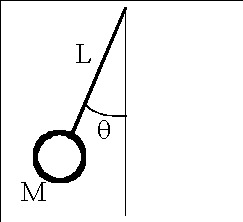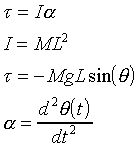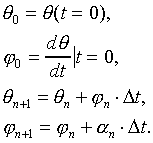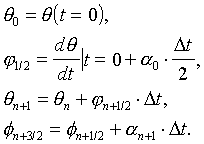
1. Introduction
This problem builds upon the two previous spreadsheets, and introduces a problem that is often discussed in physics textbooks, but rarely solved explicitly

The problem is to determine the motion of a simple pendulum, oscillating in a plane under the influence of gravity. The pendulum is a mass M at the end of a very light rigid rod of length L. Since the mass is confined to a plane at the end of a fixed-length rod, this is a one-dimensional problem in terms of an angle q. Let q=0 when the rod is hanging vertically downward. The motion of the mass is defined by the equations:
 [1]
[1]
These equations are the torque equation, definition of moment
of inertia, definition of torque, and definition of angular acceleration,
respectively.
Combining these expressions, you can get the equation of motion for the angle q, as
 . [2]
. [2]For very small q, sin(q)»q, and the simple-harmonic oscillator formula results:
 , [3]
, [3]where w2=g/L, which has the solution
 , [4]
, [4]
where we have defined the initial angular position q(t=0)=q0,
and the initial angular velocity f
= dq/dt at time t=0.
This is all straightforward. When the initial angle is not small,
or the initial angular velocity is not small, this problem does
not have a simple analytical solution. However, your spreadsheet
skills can be used to solve the problem by integration of the
equation of motion. This requires two steps. You start with a
given angle and angular velocity (the initial conditions). From
these, you calculate a new position from the velocity, and a new
velocity from the acceleration:
Euler Method:
 [5]
[5]Half-Step Method:
 [6]
[6]In all of this, the angular acceleration is given by
 . [7]
. [7]
With these simple expressions, you have solved a second-order
differential equation by two steps of numerical integration.
2. Tasks
Let the length of the rod be L= 10 meters. Determine a small step size in time Dt, and a number of steps N, so that you calculate the angle q(t) for 2 complete oscillations for the limiting case of when q(t=0) is small (less than about 15 degrees).
EXTRA CREDIT: If you start the pendulum at the top with some additional
velocity, it will have a very different behavior in the ``phase
plane'', since it will no longer have a simple oscillatory behavior.
EXTRA CREDIT: Put in some friction in the pendulum bearing. The friction force is a torque that acts in the direction opposite to the angular velocity (f) of the pendulum. You can write this as
 ,
,where the angular velocity is f=dq/dt, and k is the coefficient of friction (you could use k=0.1).